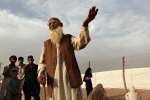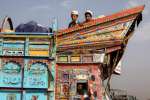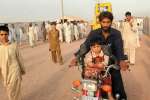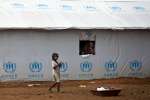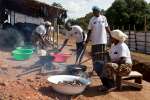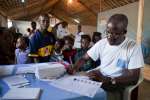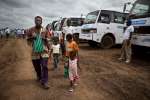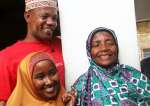Coming Home: Sri Lankan refugees return
News Stories, 13 August 2010
COLOMBO, 10 August (UNHCR)- The number of refugees returning home to Sri Lanka from India with UNHCR's help in the first half of 2010 has surpassed the total number for all 2009. This trend is expected to continue.
"The numbers of returns are not currently high, but it is significant to see that they have already exceeded that of all 2009. We can expect more refugees will start to consider returning home, reconnecting with their families and rebuilding their lives in this post-conflict phase," said UNHCR's Representative in Sri Lanka Michael Zwack.
According to Indian government figures some 73,000 Sri Lankan refugees are living in 112 camps in the southern Indian state of Tamil Nadu with a further 34,000 outside the camps.
UNHCR statistics show that in the first six months of this year, 852 refugees returned from India with UNHCR's help compared to a total of 823 for all of 2009. A further 1,005 refugees returned on their own accord – what UNHCR calls 'spontaneous' returns – and approached UNHCR offices in Sri Lanka for assistance. However, in the same period at least 386 refugees from Sri Lanka newly arrived in India.
In May 2009, a three-decade long conflict between government forces and the rebel separatist group the Tigers of Tamil Eelam commonly known as the LTTE, came to end. During the final phase of the war, there was massive displacement of the population in the north with some 276,000 displaced.
But now, tens of thousands of internally displaced people are returning to their homes in the north and it seems that some refugees abroad are also opting to return. The Menik Farm site in Sri Lanka, once a huge camp hosting 228,000 internally displaced people at its peak, now has a dwindling population of around 35,300. The camp continues to diminish in size with some 3,000 people returning to their homes every week.
UNHCR has been working for 20 years in Sri Lanka, mainly focusing on the situation of internally displaced people and providing humanitarian assistance. At various times, usually coinciding with a lull in the conflict, refugees have returned. But now with the conflict over, UNHCR is also helping returning refugees – part of its core mandate role.
"I came back because my mother who stayed here wanted me to return," one refugee returnee told UNHCR in Vavuniya, in the north of the country. He had been living in one of the refugee camps in Tamil Nadu for four years with his young family. A trained mason, he wants to get back to work as soon as possible.
He said he was happy to be back, adding that there were others in the refugee camps who also wanted to return home.
UNHCR helps refugees returning by providing them with non-food items such as mosquito nets, sleeping mats, clothing, kitchen sets, buckets, lanterns at its offices in Vavuniya, Mannar, Jaffna and Trincomalee.
UNHCR has access to the Sri Lankan refugees in India but does not work in the Sri Lankan refugee camps in Tamil Nadu. The camps were established by the Indian government and are directly managed by the authorities there. Sri Lankan refugees wanting to return home can approach UNHCR's office in Chennai for assistance.
Other refugees live outside the camps in India, such as a 39 year-old refugee returnee who came to UNHCR's Vavuniya office to get assistance. Preferring to remain anonymous, she told UNHCR she went to India from the Menik Farm camp in August 2009 after losing her husband during the massive displacement in the final phase of the war. Unable to find him, she left with other relatives going to India, taking along her two young children.
"First it was the peace situation that made me decide to return. Also, because my aunt said she was here and would help look after the family. So I came back," she said.
"This is better than being in India," she said, breaking into a smile at being home, adding that other Sri Lankan families she met in India living outside the refugee camps were also thinking of returning.
Most of the refugees return from India by air where they are met by UNHCR staff and helped with transportation to their home areas. Some spontaneous returnees also continue to arrive on their own, either by air or by irregular boat movements.
Overall, there are 146,098 Sri Lankan refugees in 64 countries with the majority in India. Sri Lankan refugees in other countries are also starting to express interest to UNHCR offices about returning home voluntarily.
By Jennifer Pagonis in Colombo, Sri Lanka








